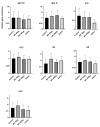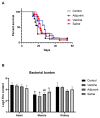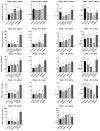The Use of Extracellular Membrane Vesicles for Immunization against Francisellosis in Nile Tilapia (Oreochromis niloticus) and Atlantic Cod (Gadus morhua L.)
- PMID: 33435503
- PMCID: PMC7827370
- DOI: 10.3390/vaccines9010034
The Use of Extracellular Membrane Vesicles for Immunization against Francisellosis in Nile Tilapia (Oreochromis niloticus) and Atlantic Cod (Gadus morhua L.)
Abstract
Francisellosis in fish is caused by the facultative intracellular Gram-negative bacterial pathogens Francisella noatunensis ssp. noatunensis and Francisella orientalis. The disease is affecting both farmed and wild fish worldwide and no commercial vaccines are currently available. In this study, we tested isolated membrane vesicles (MVs) as possible vaccine candidates based on previous trials in zebrafish (Danio rerio) indicating promising vaccine efficacy. Here, the MV vaccine-candidates were tested in their natural hosts, Atlantic cod (Gadus morhua L.) and Nile tilapia (Oreochromis niloticus). Injection of MVs did not display any toxicity or other negative influence on the fish and gene expression analysis indicated an influence on the host immune response. However, unlike in other tested fish species, a protective immunity following vaccine application and immunization period could not be detected in the Atlantic cod or tilapia. Further in vivo studies are required to achieve a better understanding of the development of immunological memory in different fish species.
Keywords: Atlantic cod; fish disease; francisellosis; membrane vesicles; tilapia; vaccine.
Conflict of interest statement
The authors declare no conflict of interest. The funders had no role in the design of the study; in the collection, analyses, or interpretation of data; in the writing of the manuscript, or in the decision to publish the results.
Figures






Similar articles
-
Francisella noatunensis subspecies noatunensis clpB deletion mutant impairs development of francisellosis in a zebrafish model.Vaccine. 2017 Dec 19;35(52):7264-7272. doi: 10.1016/j.vaccine.2017.11.009. Epub 2017 Nov 16. Vaccine. 2017. PMID: 29153776
-
Characterization and Vaccine Potential of Membrane Vesicles Produced by Francisella noatunensis subsp. orientalis in an Adult Zebrafish Model.Clin Vaccine Immunol. 2017 May 5;24(5):e00557-16. doi: 10.1128/CVI.00557-16. Print 2017 May. Clin Vaccine Immunol. 2017. PMID: 28331079 Free PMC article.
-
Efficacy of an inactivated whole-cell injection vaccine for nile tilapia, Oreochromis niloticus (L), against multiple isolates of Francisella noatunensis subsp. orientalis from diverse geographical regions.Fish Shellfish Immunol. 2019 Jun;89:217-227. doi: 10.1016/j.fsi.2019.03.071. Epub 2019 Apr 2. Fish Shellfish Immunol. 2019. PMID: 30951851
-
Francisella infections in farmed and wild aquatic organisms.Vet Res. 2011 Mar 8;42(1):47. doi: 10.1186/1297-9716-42-47. Vet Res. 2011. PMID: 21385413 Free PMC article. Review.
-
Francisella infections in fish and shellfish.J Fish Dis. 2011 Mar;34(3):173-87. doi: 10.1111/j.1365-2761.2010.01226.x. J Fish Dis. 2011. PMID: 21306585 Review.
Cited by
-
Protective potential of outer membrane vesicles derived from a virulent strain of Francisella tularensis.Front Microbiol. 2024 Mar 12;15:1355872. doi: 10.3389/fmicb.2024.1355872. eCollection 2024. Front Microbiol. 2024. PMID: 38533334 Free PMC article.
-
Proteome analysis of the Gram-positive fish pathogen Renibacterium salmoninarum reveals putative role of membrane vesicles in virulence.Sci Rep. 2022 Feb 22;12(1):3003. doi: 10.1038/s41598-022-06130-w. Sci Rep. 2022. PMID: 35194033 Free PMC article.
-
Editorial of Special Issue "The 2nd Edition: Vaccines for Aquaculture".Vaccines (Basel). 2022 Aug 3;10(8):1242. doi: 10.3390/vaccines10081242. Vaccines (Basel). 2022. PMID: 36016130 Free PMC article.
References
-
- McCoy G.W., Chapin C.W. Further Observations on a Plague-Like Disease of Rodents with a Preliminary Note on the Causative Agent, Bacterium Tularense. [(accessed on 7 June 2020)];J. Infect. Dis. 1912 10:61–72. doi: 10.1093/infdis/10.1.61. Available online: http://www.jstor.org/stable/30071893. - DOI
-
- Olsen A.B., Mikalsen J., Rode M., Alfjorden A., Hoel E., Straum-Lie K., Haldorsen R., Colquhoun D.J. A systemic granulomatous inflammatory disease in wild Atlantic cod, Gadus morhua associated with a bacterium of the genus Francisella. J. Fish Dis. 2006;29:307–311. doi: 10.1111/j.1365-2761.2006.00714.x. - DOI - PubMed
-
- Mikalsen J., Colquhoun D.J. Francisella asiatica sp. nov. isolated from farmed tilapia (Oreochromis sp.) and elevation of Francisella philomiragia subsp. noatunensis to species rank as Francisella noatunensis comb. nov., sp. nov. Int. J. Syst. Evol. Microbiol. 2009 doi: 10.1099/ijs.0.002139-0. - DOI - PubMed
-
- Svensson K., Larsson P., Johansson D., Byström M., Forsman M., Johansson A. Evolution of Subspecies of Francisella tularensis. [(accessed on 18 August 2020)];J. Bacteriol. 2005 187:3903–3908. doi: 10.1128/JB.187.11.3903-3908.2005. Available online: http://jb.asm.org/content/187/11/3903.abstract. - DOI - PMC - PubMed
Grants and funding
LinkOut - more resources
Full Text Sources
Other Literature Sources

